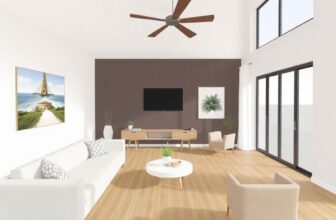
Architectural Design Trends Shaping Australian Homes in 2025
Australian homes in 2025 will transform our perspective on living spaces. Eight distinct architectural styles stand out as the leading designs for modern homes. James Hardie’s Modern Homes Forecast highlights these styles: Box Modern, Modern Farmhouse, Modern Heritage, Japandi, Barn, Modern Coastal, Mid-Century Modern and Modern Classical. These styles will define Australia’s residential architecture.
The 2025 design landscape responds to four key lifestyle themes: building efficiencies, flexibility, resilience and wellbeing. Homeowners who adopt energy-efficient house designs can reduce their utility bills by $1,200 each year. Modern homes now rest on the foundation of sustainability, which has become more than just an added feature.
Home designs have undergone a radical change with climate resilience taking centre stage. Every aspect is getting new design choices, from outdoor cladding to interior wall panels and battens. Houses now feature durable, low-maintenance materials that can withstand extreme weather. These designs naturally blend nature into living spaces through biophilic elements. Modinex explores designs that create beautiful homes that serve practical purposes and meet our changing lifestyle needs.
Architectural Styles Defining Australian Homes in 2025
The Australian home landscape of 2025 shows an amazing development of architectural styles that combine functionality with unique visual appeal. Here are the four most important styles that shape homes throughout the country this year.
Box Modern and its Geometric Appeal
Box Modern design draws attention through bold geometric forms and clean lines. This style features minimalist aesthetics, flat roofs and strong geometric shapes that create simple and open spaces. The design works with modular options and creates eye-catching yet simple façades through three main variations: the stacked box style, the cube, and the box with angles.
Box Modern’s popularity comes from its adaptability and budget-friendly approach in both new builds and renovations. The simple structural profile lets homeowners customise interior layouts while keeping a unique exterior look that makes homes stand out in any neighbourhood.
Modern Farmhouse: Rustic Meets Refined
Modern Farmhouse style has grown in 2025 and balances rustic charm with contemporary refinement beautifully. You’ll find gabled roofs, large verandas, and a careful mix of timber, metal and stone materials. This style merges the warmth of traditional farmhouse looks with modern elements through clean lines, neutral colour palettes, and a combination of rustic and sleek materials.
Modern Farmhouse interiors showcase neutral shades – whites, beige, and grey variations that go together with organic greens like sage, eucalypt and olive. These spaces feel sophisticated yet deeply comfortable.
Japandi: the Rise of Calm Minimalism
Japandi has become one of 2025’s leading styles and offers a peaceful alternative to busier design approaches. Japanese minimalism meets Scandinavian functionality with clean lines, neutral colour palettes, and natural materials. Spaces feel simple yet warm, using natural materials and straightforward floor plans to create a peaceful atmosphere.
Japandi homes often use sliding doors to extend living areas into gardens, which creates a smooth indoor-outdoor flow. These homes give people the perfect escape from busy Australian life.
Modern Classical and Mid-Century Revival
Modern Classical design has gained huge popularity among Australian homeowners because it mixes timeless architectural elements with modern functionality. You’ll see symmetrical facades, classical proportions, and arches that use durable, low-maintenance materials.
The Mid-Century Modern revival brings back design principles from the mid-20th century with modern improvements. Flat planes, large glass windows, and open spaces define this style. Today’s versions include eco-friendly building practices and smart technologies that improve efficiency and comfort.
Lifestyle Themes Driving Design Trends
Australian homes in 2025 go way beyond looks and style. Let’s take a closer look at four key themes that are changing how we live in our homes.
Building Efficiencies for Cost and Energy Savings
Building costs are 27.6% higher than early 2020, and efficiency isn’t optional anymore. The Design for Place programme gives away free eco-friendly home plans. These plans can cut heating and cooling energy needs by 40%. This is a big deal as it means that many designs beat the minimum 7-star NatHERS requirement, with some hitting amazing 10-star ratings.
Smart eco-friendly features do more than just save money. Homes that use less energy need less heating and cooling. Homeowners save between $140-210 each month. The extra upfront cost? Just $60-80 monthly. Good insulation and the right house orientation are now must-haves, not luxuries.
Designing for Wellbeing and Mental Health
A home’s quality is a vital part of mental health. Studies show that specific design choices boost residents’ mental wellbeing scores. Natural light helps regulate sleep patterns, and nature exposure improves memory, focus and lowers stress.
Nature-inspired design elements are now standard features in homes. They connect people with the outdoors through materials, views and plants. Modern homes use internal courtyards, big windows and natural materials to help people feel better mentally.
Flexible Spaces for Evolving Lifestyles
One in five Australians now live in multi-generational homes. Money pressures, housing shortages and our ageing population make more people share living spaces.
New home designs work for everyone with wider hallways, easy-to-use bathrooms and layouts that change as needed. Sliding walls, rooms that serve multiple purposes and modular furniture help spaces adapt throughout the day.
Resilience in the Face of Climate Change
Climate risk affects 1.6 million Australian homes today. This number could reach 2.6 million by 2050. Designers now create homes that protect against environmental challenges.
Eco-friendly design principles have become common practice. They include super-insulation, airtight construction and heat recovery ventilation. Materials now need to handle extreme conditions, resist fires, protect against moisture damage and keep termites out.
Global and Local Influences on House Trends
Australian residential design faces powerful external forces that go way beyond the reach and influence of aesthetics. These influences are reshaping how we think about, build and live in our homes.
How AI and Technology are Shaping Design
Technology breakthroughs are changing architectural practices in Australia faster than ever. About 41% of architectural practices now utilise AI tools. Small firms experiment with everything from ChatGPT to advanced visualisation engines. All the same, this transformation brings up questions about how images relate to reality. One expert points out, “An image of a building is not a design”. This highlights AI’s strength in visualisation but shows its limitations when it comes to qualitative assessments needed to turn concepts into viable structures.
The Effect of Climate and Environmental Concerns
Climate resilience has become essential in today’s Australian home design. Climate change will bring higher temperatures, more frequent heatwaves and increased storm events. Homes built today must withstand these conditions for decades. Yes, it is concerning that Brisbane homes will just need more than double the cooling energy by 2050 compared to the 1990-2015 baseline. The Design for Place programme offers free energy-efficient home plans as a response. These plans can cut heating and cooling energy costs by up to 40%.
Social Shifts: Loneliness, Community, and Home Layouts
One-third of Australians say they feel lonely often or most of the time. This reality drives architects to rethink home layouts completely. Multi-generational living has become the fastest-growing household type. Projections show it will grow from one in five Australians now to one in three by 2041. This social transformation calls for environments that encourage meaningful interactions through shared spaces while maintaining private retreats.
Economic Pressures and the Rise of Compact Living
Economic realities push Australians towards more compact, efficient living spaces. The Australian Bureau of Statistics shows average dwelling size has decreased steadily in the last 15 years. The ACT saw more than 70% of new home constructions as apartments in 2022/23. The region’s detached homes have grown to an average of 263m², exceeding the national average of 238m². These regional differences continue to shape Australia’s housing solutions uniquely.
Material and Aesthetic Innovations in 2025
Australian homes in 2025 blend sensory elements with aesthetics. Designers now prioritise textures that appeal to both touch and sight. The result? Spaces feel as amazing as they look.
Natural Materials and Mixed Facades
Contemporary Australian home design features a mixed cladding approach. Complementary or contrasting textures create eye-catching exteriors. Natural stone façades – including sandstone, limestone, and granite – attract homeowners because of their earthy appearance and weather resistance. These materials blend with natural timber elements like spruce, cypress pine, and blackbutt that add warmth and character. This diverse treatment makes homes stand out and lets owners express their style. The combination of brick with industrial-style window shrouds and timber accents gives facades an impressive street presence.
Biophilic Design and Indoor-outdoor Flow
Biophilic design stands as one of 2025’s most important aesthetic movements. This approach brings the outdoors in through natural light, ventilation, plants, and environmental integration. Indoor-outdoor living remains fundamental to Australian lifestyle.

Landscaping plays a crucial role in creating seamless connections. French doors, bifolds, and sliding glass doors eliminate boundary lines. Consistent material palettes extend from interior to exterior spaces.
Smart Home Integration from the Ground Up
Smart home technologies transform Australian residential architecture. Systems now control lighting, climate, security, and entertainment. By 2023, 7.6 million Australian homes had at least one smart device. Modern luxury homes feature integrated automation systems that anticipate their occupants’ needs. These technologies are a great way to get both convenience and efficiency. Features like energy monitoring help reduce consumption while keeping homes comfortable.
Warm Minimalism and Quiet Luxury
Australian homeowners embrace “warm minimalism” that combines minimalist simplicity with inviting elements. This style differs from stark minimalism by incorporating earthy colours like terracotta and soft greys, natural materials, and cosy textiles. Quiet luxury evolves to show “a little more personality” in 2025. Soft, simple pieces and comfort-focused colours take centre stage. This approach balances decluttered spaces with personal touches, creating homes that feel both peaceful and lived-in.
Conclusion
Australian homes in 2025 showcase a perfect mix of beauty and function. Eight architectural styles – from Box Modern to Japandi – give homeowners different ways to show their style while meeting their everyday needs. These designs do more than just look good. They respond to four vital themes that make our living spaces what they are.
Smart design choices help homeowners save money through better energy efficiency. Homes need to adapt as more families choose multi-generational living across Australia. Living spaces must change with family structures and needs at different life stages.
Building resilient homes is no longer just nice to have – it’s essential with Australia’s tough climate conditions. Design now focuses on wellbeing too. Natural elements and thoughtful spaces help mental health by connecting people with nature.
Money still affects housing choices, but Australian homeowners create unique personal spaces anyway. They mix materials to build one-of-a-kind exteriors that blend natural elements with modern finishes. Warm minimalism provides a cosy alternative to cold, clinical spaces.
Australian residential architecture will keep evolving. Smart technology built from the ground up will become the norm rather than a luxury. The core values of sustainability, adaptability, resilience and wellbeing will guide us. These principles help us build homes that don’t just shelter us – they improve our lives.




